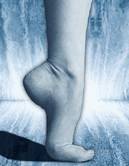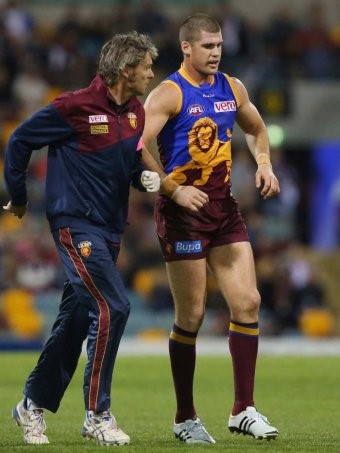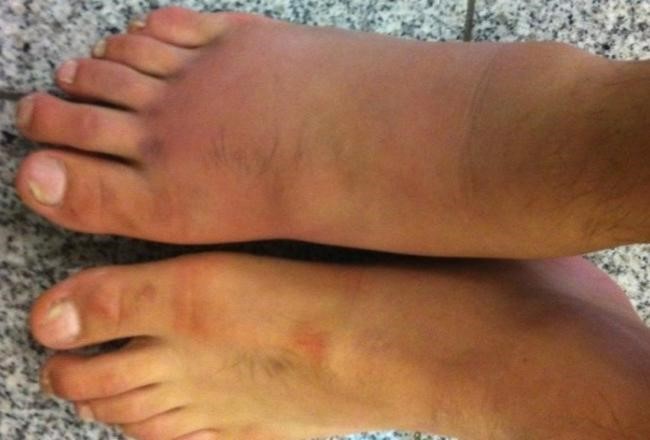Connect With Us
Items filtered by date: September 2013
Teacher Inspires Others by Participating in Half Marathon in Walking Brace
 Teacher Barbie Barnett took part in this year’s Rock ‘n’ Roll Chicago Half Marathon in spite of adversarial circumstances. In 2009, Barnett’s right foot and lower section of her right leg became paralyzed while she was recovering from back surgery.
Teacher Barbie Barnett took part in this year’s Rock ‘n’ Roll Chicago Half Marathon in spite of adversarial circumstances. In 2009, Barnett’s right foot and lower section of her right leg became paralyzed while she was recovering from back surgery.
Barnett suffered from foot drop, a condition that weakens the muscles that move the front part of the foot. With the assistance of an ankle-foot orthotic brace, Barnett eventually learned how to walk again. “My brace helped me gain…mobility and independence” Barnett said about her rehabilitation therapy and participation in the event, hoping to serve as an inspiration to others enduring the same condition.
If you have a need for ankle-foot orthotics, it is highly recommended to seek the care of a podiatrist, like Dr. Howard Hyman of The Podiatry Center, P.C. Dr. Hyman can work with you on treatment options for your foot conditions that might require the use of ankle-foot orthotics.
Ankle Foot Orthotics and What They Do
Usually used for the foot or ankle, orthotics provide support for weakened limbs or help direct the limbs so they may function properly. These orthotics can help strengthen muscles as well as benefitting muscles that need to be loosened or lengthened. Usually the orthoses is designed in a rigid L shape that is contoured to the calf and flesh colored in order to blend with the patient’s appearance.
When are Orthotics Necessary?
Orthotics are prescribed when someone is diagnosed with diseases that affect the musculature such as polio and multiple sclerosis. However, ailments such as arthritis and stroke, or foot conditions that “toe in”, may also require orthotics.
As opposed to metal braces of previous years, modern orthotics have improved tremendously. Many of today’s orthotics are manufactured with lightweight plastics and other advanced materials to provide new levels of support and comfort.
If you have any questions, please feel free to contact our office in Milburn NJ. We offer the newest diagnostic and treatment technologies for all your foot ankle injuries.
Read more on Ankle Foot Orthotics.
Blood Vessel Proteins To Blame For Cold Feet According to Research
 A research study in the American Journal of Physiology-Cell Physiology suggests a new understanding of why cold feet happen. Scientists pinpointed specific proteins in the blood vessels that cause a reaction when the body is exposed to very low temperatures. The body's normal response to cold is to restrict blood flow to the extremities, but in people with cold feet, the proteins overreact and limit circulation too much, causing overly cold feet and hands.
A research study in the American Journal of Physiology-Cell Physiology suggests a new understanding of why cold feet happen. Scientists pinpointed specific proteins in the blood vessels that cause a reaction when the body is exposed to very low temperatures. The body's normal response to cold is to restrict blood flow to the extremities, but in people with cold feet, the proteins overreact and limit circulation too much, causing overly cold feet and hands.
Cold feet due to poor circulation are a difficult condition to treat. If you are experiencing overly cold feet that you think might be due to poor circulation, you should seek the care of a podiatrist like Dr. Howard Hyman of The Podiatry Center, P.C. Dr. Hyman will give you a thorough examination to determine the cause of your cold feet and recommend appropriate treatment options.
What is Poor Circulation?
Poor blood circulation in the feet and legs is caused by peripheral artery disease (PAD), which is the result of a buildup of plaque in the arteries.
Plaque buildup or atherosclerosis results from excess calcium and cholesterol in the bloodstream. It usually restricts the amount of blood which flows through the arteries. Poor blood circulation in the feet and legs is sometimes caused by inflammation in the blood vessels, known as vasculitis.
Causes
Lack of oxygen and oxygen from poor blood circulation restricts muscle growth and development.
It can also cause:
- Muscle pain
- Numbness in legs
- Cramps
- Skin discoloration
- Weakness
- Slower nail & hair growth
- Stiffness
- Erectile dysfunction
Those who have diabetes and or smoke are at greatest risk for poor circulation, or who are over 50.
For more information please follow the link below.
If you have any questions, please feel free to contact our office in Milburn NJ. We offer the newest diagnostic and treatment technologies for all your foot ankle injuries.
Read the Full Article on Poor Circulation in the Feet.
Footballer Incurs Potential Career Ending Injury
 Jonathan Brown of the Brisbane Lions suffered a foot injury that just might mark the end of his athletic career. The 31 year old forward seems to have torn his plantar fascia and will be visiting a surgeon next week to get a better observation of his injury.
Jonathan Brown of the Brisbane Lions suffered a foot injury that just might mark the end of his athletic career. The 31 year old forward seems to have torn his plantar fascia and will be visiting a surgeon next week to get a better observation of his injury.
Although Lions coach Michael Voss hopes Brown will play in 2014, Brown himself is unsure. “I just don’t want to go out there and play for the sake of it, or play for the money. I want to go out there and still be able to contribute.” Brown said “If I played my last game, so be it. I can live with that,” Brown told the AFL Footy Show.
Facing such an injury can be daunting, but with proper care returning to sports and activities is not impossible. Receiving treatment from a podiatrist such as Dr. Howard Hyman of The Podiatry Center, P.C. can help you manage your injury as well as provide solutions for how to get back into the sports you enjoy.
Getting Back into Sports after Foot and Ankle Injuries
Sprained ankles are a frustrating and painful ordeal many athletes go through. Recovery from a sprained ankle usually involves the RICE method. This includes:
- Rest
- Ice
- Compression
- Elevation
In addition, athletes should consider wearing an ankle brace in order to keep the ankle stabilized and alleviate any pain as it heals.
Stress fractures that occur in the foot and ankle come in two types. This includes stable and displaced. Stable stress fractures do not consist of any shifting in bone alignment while displaced stress fractures involve bone ends that do not line up.
Learn more about getting back into sports after foot and ankle injury by following link below.
If you have any questions, please feel free to contact our office in Milburn NJ. We offer the newest diagnostic and treatment technologies for all your foot ankle injuries.
Read more on Getting Back into Sports after Foot and Ankle Injuries.
Fighter Suffers Broken Foot during Fight at UFC 163
a
 Professional MMA fighter Chan Sung Jung fractured his orbital bone during the battle against featherweight champion Jose Aldo at UFC 163. Jung, known as The Korean Zombie, was taken down when Aldo kicked the injured area during the fight, following up by Jung with several strikes on the ground for the TKO.
Professional MMA fighter Chan Sung Jung fractured his orbital bone during the battle against featherweight champion Jose Aldo at UFC 163. Jung, known as The Korean Zombie, was taken down when Aldo kicked the injured area during the fight, following up by Jung with several strikes on the ground for the TKO.
While the official prognosis for Jung’s foot is unknown, his opponent Aldo will actually be out of the cage for the rest of 2013, also suffering a broken foot. Jung, who had a three win streak prior to losing to Aldo, will be meeting with specialists to discuss treatment options for his fracture.
Dealing with a broken foot can be a painful ordeal. However, an injury like this can be managed and taken care of by a podiatrist like Dr. Howard Hyman of The Podiatry Center, P.C. Dr. Hyman can examine your broken foot, determine the severity of your injury, and work with you to provide the appropriate treatment options.
Broken Foot Causes, Symptoms, and Treatment
A broken foot is caused by one of the bones in the foot ‘breaking’, or fracturing. Bones typically break when the bone is either bended, crushed, or stretched beyond its natural capabilities. Usually the location of the fracture indicates how the break occurred, whether it was through an object, fall, or any other type of injury.
Common Symptoms of Broken Feet:
- Bruising
- Pain
- Redness
- Swelling
- Blue (foot)
- Numbness
- Cold
- Misshapen
- Cuts
- Deformities
Those who are experiencing any of these symptoms, or suspect that they have a broken foot, should seek medical attention in a center where x-rays can be performed. This is especially urgent if any of the symptoms include numbness, blue coloring, cold feet, cuts, misshapen toes or deformities as these indicate more severe cases.
Treatment for broken bones varies depending on the cause, severity and location. Some will require the use of splints, casts or crutches while others could even involve surgery to repair the broken bones. Personal care includes the use of ice and keeping the foot stabilized and elevated. Trying to keep the foot rested is important as the bones need plenty of time to heal and recover.
If you have any questions, please feel free to contact our office in Milburn NJ. We offer the newest diagnostic and treatment technologies for all your foot ankle injuries.
Read more on Broken Foot Causes, Symptoms, and Treatment.
Blog Archives
- April 2025
- March 2025
- February 2025
- January 2025
- December 2024
- November 2024
- October 2024
- September 2024
- August 2024
- July 2024
- June 2024
- May 2024
- April 2024
- March 2024
- February 2024
- January 2024
- December 2023
- November 2023
- October 2023
- September 2023
- August 2023
- July 2023
- June 2023
- May 2023
- April 2023
- March 2023
- February 2023
- January 2023
- December 2022
- November 2022
- October 2022
- September 2022
- August 2022
- July 2022
- June 2022
- May 2022
- April 2022
- March 2022
- February 2022
- January 2022
- December 2021
- November 2021
- October 2021
- September 2021
- August 2021
- July 2021
- June 2021
- May 2021
- April 2021
- March 2021
- February 2021
- January 2021
- December 2020
- November 2020
- October 2020
- September 2020
- August 2020
- July 2020
- June 2020
- May 2020
- April 2020
- March 2020
- February 2020
- January 2020
- December 2019
- November 2019
- October 2019
- September 2019
- August 2019
- July 2019
- June 2019
- May 2019
- April 2019
- March 2019
- February 2019
- January 2019
- December 2018
- November 2018
- October 2018
- September 2018
- August 2018
- July 2018
- June 2018
- May 2018
- April 2018
- March 2018
- February 2018
- January 2018
- December 2017
- November 2017
- October 2017
- September 2017
- August 2017
- July 2017
- June 2017
- May 2017
- April 2017
- March 2017
- February 2017
- January 2017
- December 2016
- November 2016
- October 2016
- September 2016
- August 2016
- July 2016
- June 2016
- May 2016
- April 2016
- March 2016
- February 2016
- January 2016
- December 2015
- November 2015
- October 2015
- September 2015
- August 2015
- July 2015
- June 2015
- May 2015
- January 2014
- December 2013
- November 2013
- October 2013
- September 2013
- August 2013
- July 2013
- June 2013
- May 2013
- April 2013
- March 2013
- February 2013
- January 2013
- December 2012
- November 2012
- October 2012
- September 2012
- August 2012
- July 2012
- June 2012
